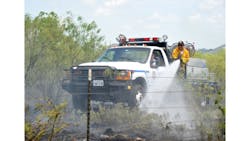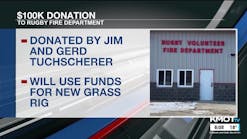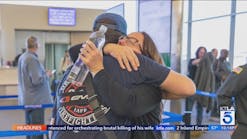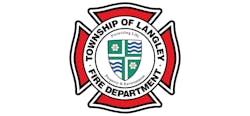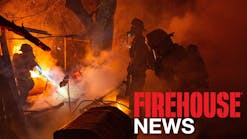Jury Still Out on Some New 2016 NFPA Apparatus Standards
It’s been six months since the new National Fire Protection Association (NFPA) standards for fire apparatus have been enacted and while most changes have been accepted and deemed reasonable, some actions have stirred up some controversies.
Every three to five years, NFPA reviews standards set for apparatus manufacturing. The cycle is actually every seven years, but it takes a while to move an idea to a standard upon which most people agree.
Firehouse talked to experts on NFPA standards to get a better understanding of what's new and what to expect in the future. Ironically, some of the things that were not adopted have caused more of a buzz than those that were adopted.
Los Angles Assistant Chief of Operations Donald Frazeur is the chairman of the NFPA Technical Committee on Fire Department Apparatus for sections 1901 and 1906. In his role with NFPA, he is responsible for synthesizing and shepherding all the divergent opinions into the standard by which most apparatus are built today.
“NFPA’s standards are consensus standards,” Frazeur said. “They’re populated by the committee.” He commented the committees are comprised of one-third from the fire service, one-third from the manufacturers and one-third from any special interest groups.
“We strive on the 1901 committee to keep that balance,” Frazeur said. “You want to have informed decisions. It’s done by committee wisdom and, in my experience, they get it pretty spot on.”
Frazeur, who made it clear he was speaking as an individual and not as a NFPA representative, said there were three “hot-button topics” in this year’s edition—external seating position for wildland firefighting, seat widths and first-time-ever ultra-high pressure pump standards.
Wildland apparatus seating
Regarding the exterior riding position, Frazeur said “the committee really worked hard on the issue. It was pretty divided.”
NFPA 1500 frowns on exterior riding positions of any kind, but the 1901 committee recognizes that it happens a lot in wildland firefighting, Frazeur said. So, the 1901 and the 1906 committees decided to take up the topic and make a standard.
“We had a chicken/egg issue,” Frazeur said. “We could make it safe, and therefore, came up with a minimum safety standard.” That way, if fire departments have to have an exterior position, the NFPA standards have minimum requirements.
“I can see the value of an exterior seat,” Frazeur said, adding that he can also see greater value in making it safe. He said it needs to be more than a bass boat seat bolted to the front bumper. The committee made the standard “pretty broad,” allowing the manufacturers to come up with best practices. “We just said it has to be safe and the rider has to be able to communicate with the driver,” Frazeur said. “We said ‘you figure out how to build it.’”
Frazeur said the committee for NPFA 1500, the Standard on Fire Department Occupational Safety and Health Program, is scheduled to meet in July and it will undoubtedly look at the exterior seating standard. While that committee can’t overrule the apparatus committee, it could decide to not endorse any exterior seating position, setting up a conflict that may have to be resolved during the next round of updates scheduled for 2020.
“I expect to see more on the seating issue,” Frazeur said. “That’s a real hot-button issue.” He commented that some departments need them as a part of their firefighting practices, while others don’t use them operationally. Additionally, not all the manufacturers of wildland firefighting equipment agree on the methods for keeping firefighters safe in exterior seating positions.
Seat widths in the cab
Another standard that was considered, and ultimately rejected, was an attempt to increase the seat size from a minimum of 22-inches in the 2009 edition to 28 inches in the current 2016 standard.
Frazeur said the National Institute for Occupational Safety and Health (NIOSH) conducted a study that concluded to accommodate firefighters in the 95th percentile, in terms of size, the seat needed to be 28 inches wide—an addition of a half foot. That requirement was championed by individuals who fought hard for the change in the standard.
“At the end of the process, we didn’t agree with the submitter,” Frazeur said. He added that the requirement was not easily achievable because cabs can only be 100-inches wide by federal regulations, and adding a foot or more in width to the apparatus was not practical given cab designs and engine space requirements, particularly for the drivers’ and officers’ seats. Wider seating in the back could be accommodated just by eliminating seats.
“Something has to give,” Frazeur said, adding that the topic eventually went to a floor fight before being sent back to committee for additional work and ultimately not included in the 2016 edition. Frazeur said whenever consensus can’t be reached on a proposed change, it reverts back to the previous standard which was agreed upon by consensus.
Roger Lackore, a widely recognized expert in NFPA standards, a former member of the apparatus technical committee since 1995 and chairman of the chassis subcommittee, offered some insight into the seat debate.
Lackore, who is a professional engineer working on heavy truck design since 1985, comes from the manufacturers’ side of the NFPA committee make up. He spent the past 18 years in the fire apparatus market and said, the anthropomorphic study done by NIOSH revealed an issue about the size of firefighters and the possible need for additional space in the seats, but did little to offer solutions on how to fix the issue.
“There are serious restrictions on the current, traditional custom fire cabs,” Lackore said, noting that it would require moving engines to get the extra space. “There physically wasn’t enough room."
A couple of manufacturers have cabs that would accommodate the wider seats, one was just developed last year by moving the engine to the rear of the apparatus.
“All the other custom cabs would have to be thrown out,” Lackore said. “When you bring something to the standards that is going to be that disruptive, you’ve got to give manufacturers more notice. It’s not like you can flip a switch and fix everything.”
Walking and stepping surfaces
Another 2016 standard that was a little controversial involved the designation of walking and stepping surfaces, delineated by yellow lines that define all the edges.
“We’ve talked about that one forever,” Lackore said. “The idea is to outline where we expect to have people and what tasks they are doing.”
Preventing walking and climbing on apparatus, especially during operating and emergency conditions, is a goal, Lackore said, noting that service operations and maintenance often require climbing and crawling.
“The idea is to make it so you don’t have to crawl or climb during emergencies,” Lackore said.
Standard signage
Another standard this year is safety sign standardization, Lackore said, adding that Boca Raton, FL, Fire Chief Thomas Wood was instrumental in having this part of the standard pass.
Wood had been buying apparatus from a half dozen manufacturers, but they didn’t have common warning signs, although all the hazards were exactly the same. So, with the help of the Fire Apparatus Manufacturers Association (FAMA), NFPA came up with common apparatus safety symbols, Lackore said.
“They are to be a training tool,” Lackore said. “They’re there to remind people of the major safety hazards of apparatus.” He added that FAMA sells the signs and they can be retrofitted on to existing apparatus. “We’re really trying to get the word out,” he said.
Ultra-high-pressure pumps
Lackore said the NFPA committee also put standards in for ultra-high-pressure pumps, a topic the previous standards had not covered.
Ultra-high pressure pumps are gaining popularity and as they do, NFPA figured it needed to have some standards, Lackore said. He noted the standards really don’t change much, but they do require a better job at testing them.
Additional updates
A couple of other smaller niche apparatus also got some attention for 2016. Forestry crew carriers were included in the standard. Lackore said, while crew carriers are exclusively used in forest fire situations, they need some standards to keep firefighters safe.
And the same is true for aerial tiller cabs, Lackore said, noting there were previously no standards for those niche units and now they be expected to meet structural integrity tests to be NFPA compliant.
Latest edition has less changes
“This year was pretty mild,” Lackore said of the NFPA changes for the 2016 edition. “We took a breather.” He said the next round of changes would likely be 2021. “That would be my crystal ball,” he said.
Ken Holland is the staff liaison for NFPA for the 1901, 1906, 1911 and 1912 apparatus committees. As an NFPA staffer, it’s his job to work with the manufacturers, the firefighter users and the special interest groups to get the standards set and published.
Many fire departments, Holland said, believe NFPA is a government organization, but it is a private, voluntarily organization that sets standards by consensus.
“You can choose to follow them or not,” Holland said.
Standards are generated by committee members, although many of them come from the general public, Holland said, explaining that NFPA accepts comments from the public on its website after the user creates an account.
The account captures the demographics of the user just so NFPA and the committees can know who is submitting what and from where. Some suggestions are dismissed immediately as being outlandish or bogus, but many are forwarded to the committee for consideration, he explained. If the appropriate committee decides to consider the proposed standard further, the submitter is asked to provide material to substantiate the need for the standard, Holland said.
If the committee is convinced the standard is needed, it will be sent out for review and public comment and then voted on by the committee, Holland said, adding at that point, it’s a new standard.
If the appropriate committee rejects the proposal, the submitter can appeal the NFPA general membership, Holland said, noting the submitter may be asked to speak at the annual meeting to make the case.
“The submitter may be able to convince the general membership the committee got it wrong and it needs to be fixed,” Holland said. If the general membership decides that the committee did get it wrong, it will be sent back to the committee for ballot voting. Conversely, the general membership may agree with the committee’s decision and the proposed standard is declined, at least for that session, Holland said.
Holland explained that sometimes there are emergency, or urgent standards that must be considered between review cycles and there’s a process for that too. That’s called the Tentative Interim Amendment (TIA), Holland said. TIAs, Holland said, are standards that need to be enacted immediately to keep firefighters and the public safe.
Some recent TIAs include one requiring all hose beds and crosslays to be covered and secured. It was passed after hose fell from an apparatus crosslay and killed a girl and seriously injured another in Pennsylvania in 2004. Another TIA was adopted in 2008 when a 200-pound motorized monitor blew off an aerial waterway and killed a deputy fire chief, also in Pennsylvania.
Holland explained that TIAs are considered and implemented immediately if deemed worthy. They are also considered at the next cycle for permanent status as a certified NFPA standard.
After just six months of the 2016 edition, Holland said there have been no TIAs requested. He did say, however, one might come in regarding the exterior seating position for wildland apparatus.
“It’s a big issue that’s gotten a lot of publicity,” Holland said, noting that he’s also the staff liaison for the NFPA 1500 committee. He said that committee will meet in July and part of the discussion will be the wildland apparatus seating.
“I’ll have to let them know it’s a big issue,” he said. “We’ve got to have some coordination on this.”
